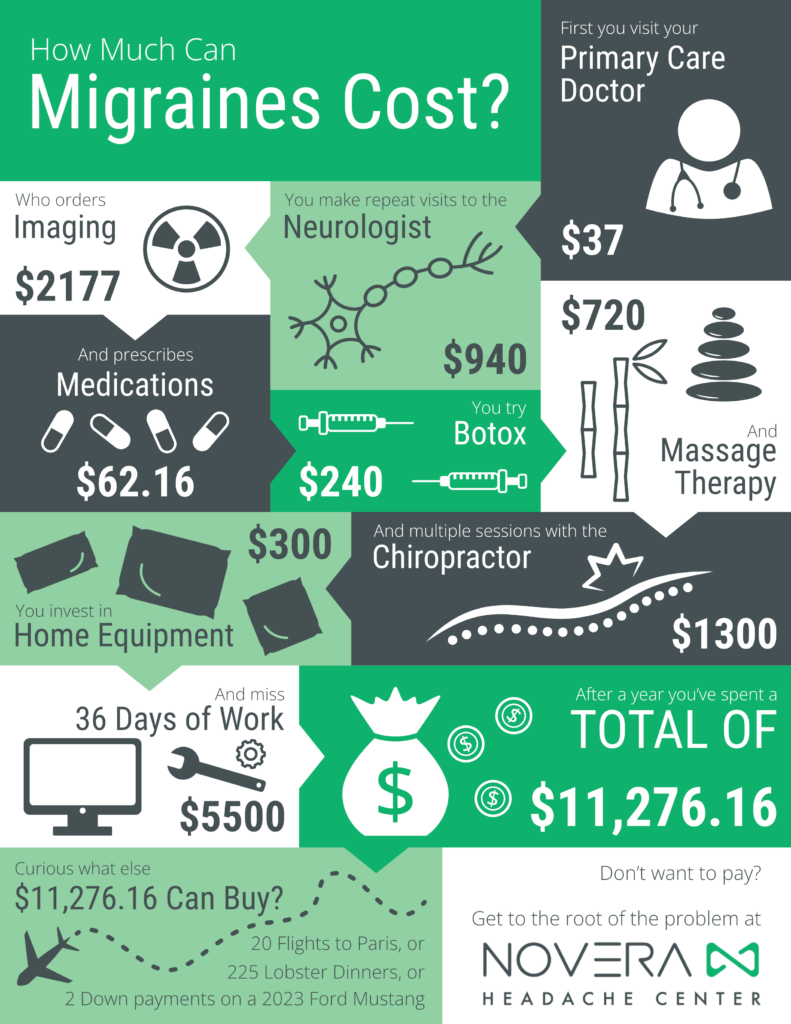Migraines are more than just debilitating headaches—they’re a chronic condition that can take a significant toll on your life, both physically and financially. For those who suffer regularly, the costs associated with managing migraines can quickly add up, often without yielding the relief or long-term results they desperately seek. But what if there was a way to address the root cause of migraines, rather than just treating the symptoms?
In this post, we’ll break down the often-overlooked financial burden of migraines and explore how a holistic, root-cause-focused approach to healthcare could be a game-changer for those struggling with this condition.

The Financial Reality of Migraine Management
When it comes to traditional healthcare, managing migraines often involves a revolving door of doctor visits, diagnostic tests, and various treatments. These expenses can accumulate rapidly. Here’s a look at what a typical year might look like for someone relying on conventional medical care:
- Doctor Visits: Starting with primary care, many patients are referred to specialists like neurologists. It’s common to see a neurologist 10 times in a year, with each visit costing around $94. Combined with other consultations, this alone can approach $1,000 annually.
- Imaging and Tests: To rule out serious conditions like brain tumors, most migraine sufferers undergo CT scans and MRIs, adding another $442 to the yearly bill, assuming insurance covers a portion of the costs.
- Medications: Daily preventive medications and abortive treatments for acute migraines are standard. Even with insurance, the cost for these prescriptions can be around $62 annually, though this varies widely based on the medication.
- Alternative Therapies: Many turn to massage therapy and chiropractic care, seeking relief where traditional medicine falls short. These treatments can add another $2,000 or more to the annual total.
When all is said and done, the annual out-of-pocket cost for managing migraines through traditional healthcare can easily reach $6,000 or more. And this doesn’t even factor in the loss of income from missed workdays, which can add thousands more to the financial burden.
The Holistic Approach: Addressing the Root Cause
Despite these significant expenditures, many migraine sufferers find that their symptoms persist. That’s because traditional healthcare often focuses on treating the symptoms rather than addressing the underlying cause. This is where a more holistic approach to healthcare comes in.
At Novera: Headache Center, we believe in getting to the root of the issue. Our approach is based on the understanding that most migraines are linked to issues in the neck, posture, or musculoskeletal system. By focusing on these areas, we aim to reduce or even eliminate the frequency and severity of migraines, offering a more permanent solution.
Rather than spending valuable time and money trying medications, getting imaging done, and attending various doctor visits, a one-time investment in a holistic treatment plan can significantly reduce or eliminate the need for ongoing traditional care. This not only saves money but also improves the quality of life.
Investing in Your Health: A Worthwhile Decision
When you consider the financial and emotional toll that migraines can take, it becomes clear that a holistic approach isn’t just about saving money—it’s about investing in your long-term well-being. By addressing the root cause of migraines, you can break free from the cycle of pain and costly treatments, regaining control over your life.
At Novera, our mission is to educate and empower individuals with headaches and migraines to make informed decisions about their health. We believe that by focusing on the underlying causes, we can help you find lasting relief and a better quality of life.
If you’re ready to explore a different path to migraine management, we’re here to guide you every step of the way.
This post is inspired by a recent episode of the Headache Doctor Podcast, where Dr. Sarah Thomas shared insights into the true cost of living with migraines and the benefits of a holistic approach to treatment.




